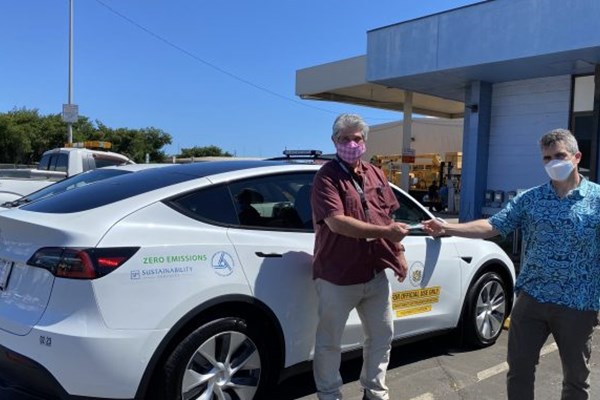HDOT aims to electrify its fleet ahead of state goal
Mar 29, 2022

It’s well documented that Hawaii imports about a third more gallons of fossil fuels for ground transportation than for electricity production, and ground transportation is a significant contributor to greenhouse gas emissions and the consumption of fossil fuels.
To address these issues, the Hawaii Legislature passed House Bill 552 in 2021 (signed into law as Act 74), establishing clean ground transportation goals for State agencies to achieve a 100% light-duty motor vehicles zero-emission fleet by Dec. 31, 2035.
The Hawaii Department of Transportation (HDOT) is aiming to beat that goal by 5 years, and has spearheaded the mechanism to accomplish the job via an innovative service contract to replace light-duty vehicles in its fleet with electric vehicles (EVs). The contract allows HDOT (as well as other State and county agencies within Hawaii) to obtain EVs and charging infrastructure as a service on a per-mile cost basis, reducing the upfront costs of electrifying fleet vehicles and reducing fuel and maintenance costs.
Innovative and cost-effective
The service contract is a cost-effective way to begin conversions of vehicle fleets to zero emissions without upfront capital costs. It’s applicable to all types of vehicles, light-duty and buses to heavy equipment, as long as the technology is available. The contract is also open to all makes and models available on the market. To ensure that the State received the best value under the service contract, HDOT considered maintenance record and resale values after the 8-10 year contract and how the EV onboard systems were upgraded.
The service contract is expected to save HDOT an average of $287 per-vehicle a year in fuel costs and 75% in vehicle maintenance costs over its lifespan. According to HDOT, every internal-combustion engine (ICE) vehicle replaced by an EV results in a reduction of an estimated 8,700 pounds of carbon dioxide annually, or 87,000 pounds with 10 EVs. The HDOT Highways Division currently has a light-duty fleet of about 300 passenger vehicles in all.
Opportunity to right-size
HDOT reports that the experience among State employees has been positive, with the vehicles’ safety features receiving exceptionally high marks from users. But the initiative has also proven to be an opportunity to right-size the fleet — to consider whether or not the current number of vehicles are needed in the first place. For example, of HDOT’s 300 light-duty vehicles on the system, the transition to EVs provides data that allows administrators to see their actual usage, providing an accurate understanding what is needed. Of the current light-duty fleet, HDOT plans to replace 240 and phase out 60 vehicles.
As of February 2022, 44 ICE vehicles have been removed from HDOT’s fleet. More EV replacements will be on their way in 2022 as HDOT Highways orders 24 sedans and 100 trucks. HDOT’s Airports Division has also started its fleet conversion with the recent receipt of six EVs.
In addition, because all departments can participate in the service contract, there are future opportunities to leverage charging infrastructure with other departments. At some locations, there may be 80 State vehicles among multiple departments, sharing that charging infrastructure.
Driving Hawaii's EV future
Ultimately, HDOT’s efforts represent strong momentum at the state level, as car manufacturers across the nation and the globe are announcing new vehicles or new commitments to go zero emission. Hawaii is helping to drive its own EV future.
“We were definitely excited to begin the service contract with Sustainability Partners as converting our aging vehicles to EVs is another way HDOT is saving money and working towards the State's goal of reducing fuel consumption in ground transportation 70% by 2030,” said HDOT Deputy Director for Highways Ed Sniffen in a news release. “Public and private ground transportation is a huge contributor to carbon dioxide emissions. This service contract, that is available to all State and county agencies, could expedite government fleet conversions and help lead the way for increased private adoption of EV.”
HDOT plans to continue converting or reducing the rest of its aging fleet to electric, and it aims to reduce or convert the entire light-duty fleet by 2030, ahead of the State goal. The department has also set a model for other government agencies across Hawaii.

